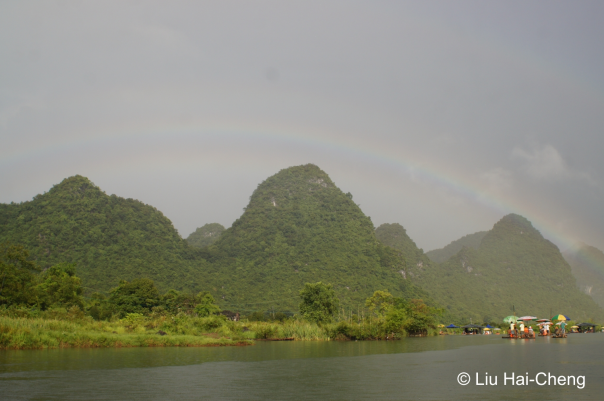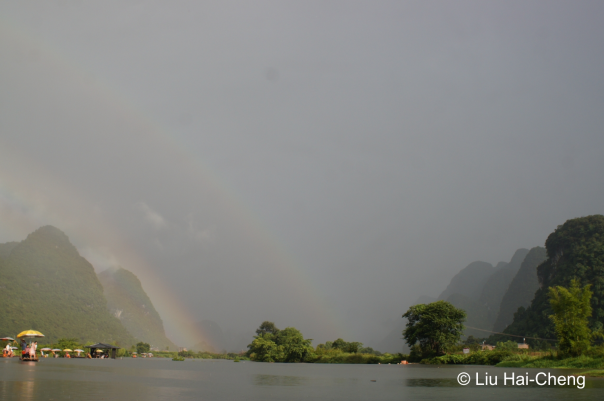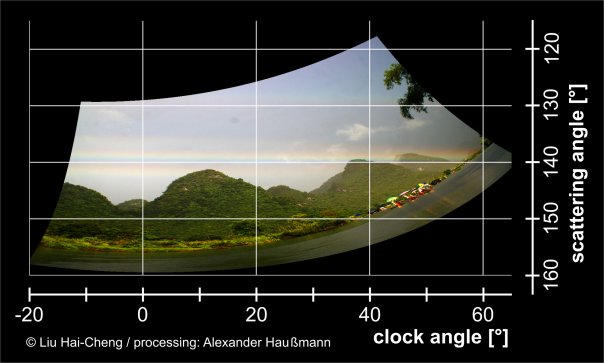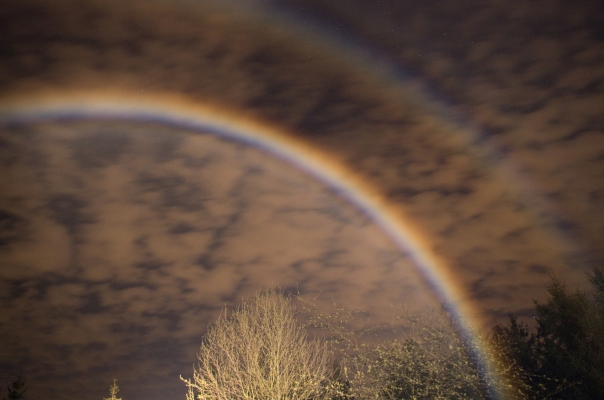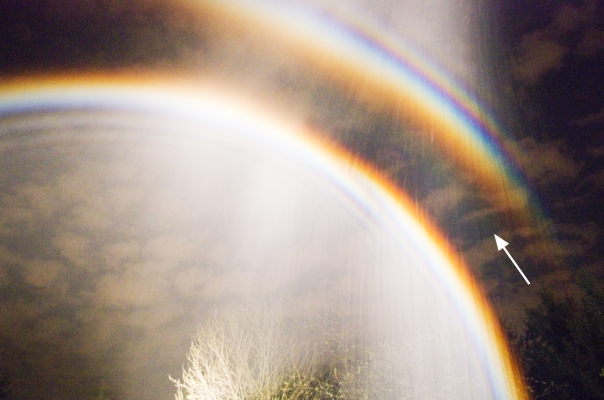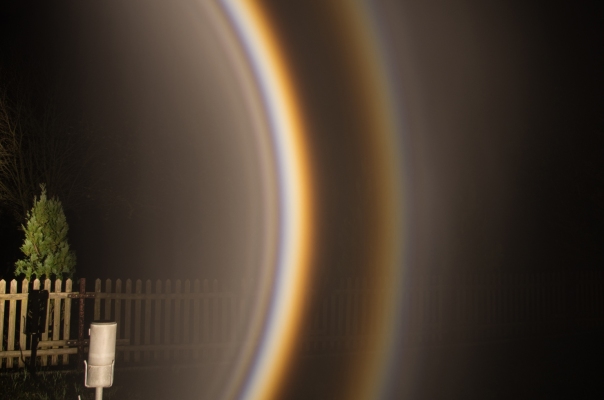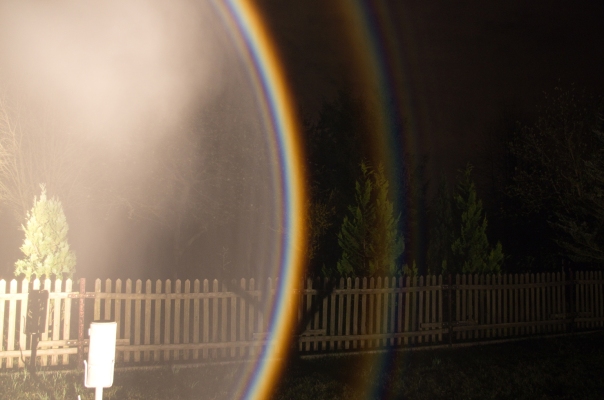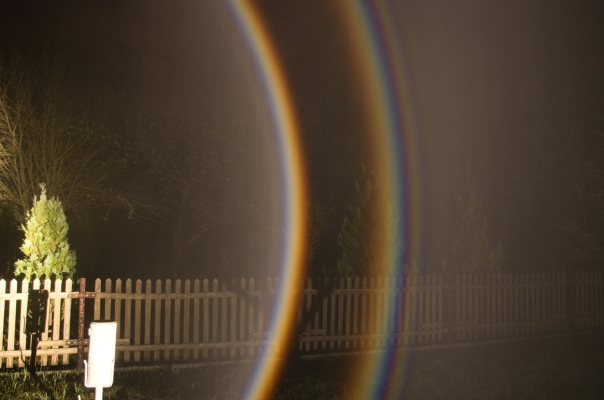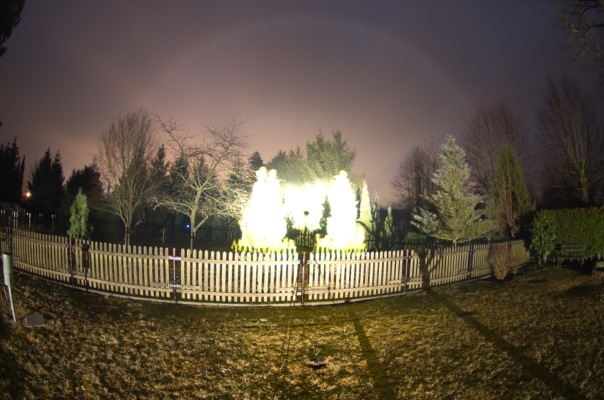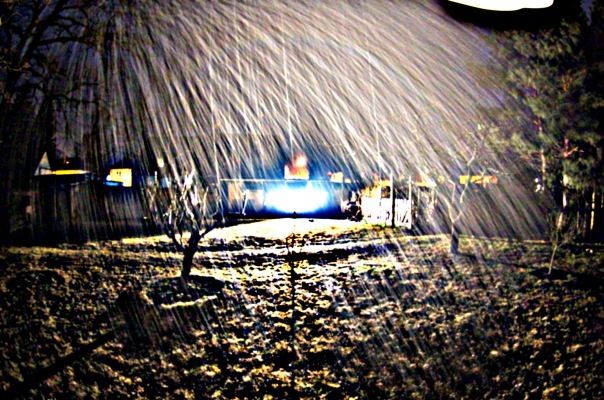Category Archives: rainbow and fogbow
Concentric 3rd and 4th order rainbows at Dresden-Langebrück, Aug 11th, 2020




Taking photographs of tertiary and quaternary rainbows is difficult, as usually you won’t see what you are aiming at – theory predicts that the tertiary is just at the threshold of visibility [1], and for the quaternary the situation is even worse. I myself have been lucky only once before [2], (though having tried for almost a decade now), if one does not count experiments using artificial sprays [3]. This cannot be attributed to a lack of opportunities. Over the years, I experienced several promising situations, but afterwards no higher order rainbows could be extracted from the photographs by image processing. One problem is that cloud structures in the background mess up the unsharp mask filter. But maybe also my timing was just wrong and these rainbows did not appear when I expect them to do, because I misjudged the shower and illumination geometry.
Anyway, on Aug 11th, 2020, my instincts were right. Just before I finished work in Dresden-Langebrück, a moderate shower moved in from the northeast. The sunlight was somewhat dim, which resulted in an unspectacular primary rainbow from 17:15 CEST onwards. I could see some larger drops glint in the sunlight. I went to my car on the parking lot during the next minutes, and lost sight to the east, so I do not exactly know what happened later on this side of the sky. The rain was still ongoing, but not heavy, there were people cycling around without looking too much disturbed. I’m not entirely sure if it was still the same rain shower, or another one which had meanwhile moved in. I took three photos at the parking lot (17:23-24 CEST), and then drove about 100 m to a spot with a good view towards the west. There was nothing to be seen with the naked eye, just the sun, some glinting raindrops, a cloud, and blue sky below. A major problem is that raindrops will fall on the front lens, especially when using a fisheye objective that cannot be shielded and has to be held out of the car window to make proper use of its field of view. So one needs to be fast, otherwise the images will be spoiled by artifacts from the drops. That is why I did not do any image stacks, just a threefold exposure bracket per shot for safety (to have at least one picture with a useful exposure). In between, I had to wipe the lens dry. All of the ten shots I took there from 17:26-30 showed the tertiary rainbow after some processing, and it also appeared on the earlier pictures from the parking lot, as far as the view permitted. I was rather overwhelmed to see more than the complete upper half of the tertiary against the blue sky and cloud background when I first applied an unsharp mask to the images. The quaternary rainbow (located just outside the tertiary) can also be detected beyond any doubts, especially on the left side. I found no supernumerary arcs and no traces of the seventh order [4] (which I had missed to pay attention to during the observation, I also did not use any polarizers, and as mentioned, I did not record image stacks).

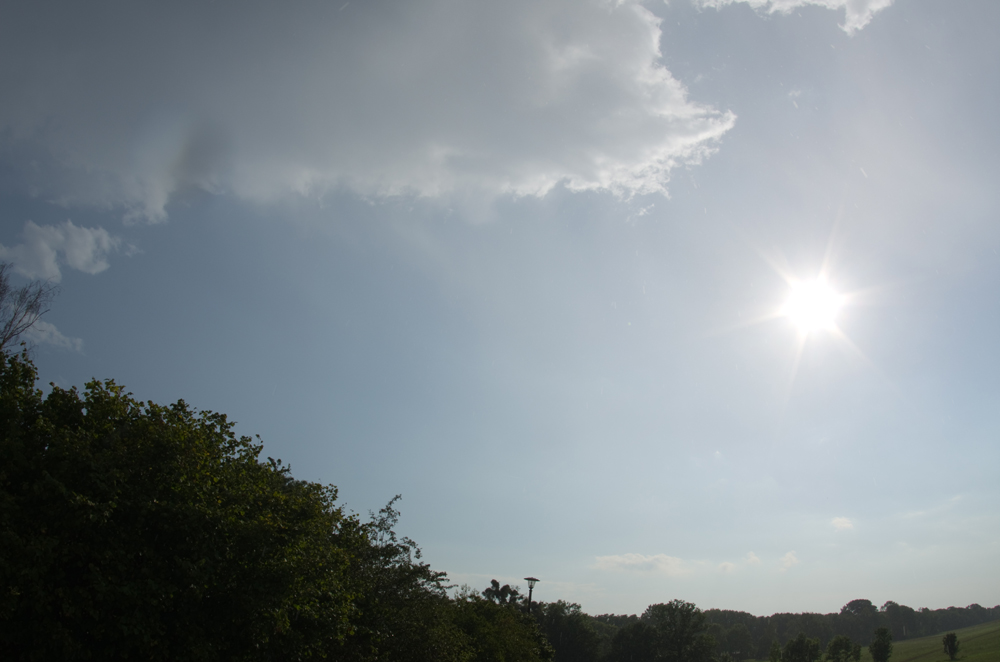


It is well known that aerodynamic flattening of larger raindrops has an impact on rainbows through the so-called Möbius shifts, but so far the consequences for higher order rainbows have only been studied theoretically. Are there any new insights from this observation? This, of course, requires an image calibration, i.e. the assignment of scattering coordinates (scattering angle and clock angle, i.e. the sun-centered azimuth, which I will count clockwise from the rainbow’s top here) to the individual pixels. The position of the sun is easily calculated from the time the respective photograph was taken (17:27:54 CEST for the top image, checked with a radio-controlled watch) and the location (51.13° N, 13.83° E), which gives in this case an elevation of 27.6° and an azimuth of 259.5°. The pixel coordinates of the sun’s center could also be reliably determined from an image version developed as dark as possible from the RAW file in Photoshop. The projection of this specific lens I had measured eight years ago (when I newly got it), but I did also a cross-check with recent starfield pictures (abundantly available from my attempts to catch Perseid meteors the following nights). In order to determine the relevant Euler angles (elevation and azimuth of the camera’s optical axis, and the rotation of the camera sensor chip around this axis), I still needed another reference mark. Luckily there was a telecommunication tower at the horizon which I could identify and then calculate under which elevation and azimuth it is seen from the observing location.
Technical sidenote: The two coordinates of the reference mark provide me indeed with one condition more than the number of available degrees of freedom, so I can check the overall consistency of the calibration. And here it initially turned out to be not very convincing. What went wrong? When checking my hidden assumptions I found that I had pinned the piercing point of the optical axis to the precise center of the CMOS sensor (in terms of pixel coordinates). This may not be realistic, and, moreover, in a Pentax K-5 camera the sensor can move several millimeters to compensate for shaking. Even with the shaking compensation turned off there is no guarantee that it will find and stay in the optical center position (plus, there are decentering errors of the lens). From the working principle of the calibration procedure I expect the decentering error to be of quadratic order, and it may turn out to be negligible for longer focal lengths. But it matters for a fisheye lens. So I used the amounts of decentering in X and Y as further degrees of freedom and achieved consistent results for a shift of 26 pixels (0.12 mm) in the horizontal (and zero in the vertical). However, a further reference mark would be needed for a truly unique determination. Then there would still remain the assumption of a rotationally symmetric lens, but this seems to be acceptable as indicated by the recent starfield test.
From an equilateral projection in scattering coordinates it can then be deduced that the tertiary does not bend significantly over the recorded range of clock angles, which also holds for the quaternary as far as it peaks out of the noise. So seemingly they appeared as perfectly concentric circles here!

This is somewhat surprising, as theory predicts that these rainbows are also subject to Möbius shifts of various amounts along their circumference, which should become noticeable if larger (more distorted) drops are involved. Interestingly, for this sun elevation the Möbius shifts will move the tops of the 3rd and 4th order rainbows towards each other. They might even overlap for an effective drop radius of 0.5 mm [5]. However, in nature, in most cases the drop size distribution (DSD) will cover a broad range of sizes, also including small drops. Because the shape distortion sets in (at least) quadratically with rising drop radius, it is likely to see some of the traditional concentric sphere-drop rainbows shine through in the full mixture of size dependent rainbows. This I already noted in simulations using broad Marshall-Palmer DSDs (i.e. a simple decaying exponential). As mentioned, there was no heavy rainfall going on during the observation on Aug 11th, so a dominance of the less distorted smaller sizes can be reasonably assumed – regrettably there are no direct measurements of the DSD. Lee and Laven [1] argue that broad DSDs tend to wipe out the tertiary’s top and leave only the sides, but their analysis was based on much lower sun elevations than occurring here.
So in order to see how much the concentricity of the tertiary and quaternary rainbows will be affected in this specific case I did some simulations for the proper sun elevation and a (guessed) DSD which contains mostly small and moderate sized drops: A Marshall-Palmer with decaying parameter (Lambda) of 4 mm-1, as previously used [5]. There are two complementary simulation methods which I can apply: 1) GO: Geometric optic raytracing (including polarization, but neglecting interference and diffraction) for all rainbow orders up to the 7th, based on a Beard-Chuang cosine series drop shape model, with optional (2,0) quadrupole mode oscillations and Gaussian tilts of the symmetry axis from the vertical, and 2) DMK: Debye series calculations for spherical drops of various sizes, superimposed in intensity after being shifted in scattering angle by the appropriate Möbius value (depending on drop size, rainbow order, and clock angle, following Können [6]). These calculation include only rainbow orders up to the 5th. The Möbius shifts themselves are taken from a look-up table comprising earlier raytracing results. These were calculated from a simpler shape model (two conjoined half spheroids fitted to Beard-Chuang shapes) and do not include drop oscillations or tilts for the higher-order rainbows yet. However, this second method has the advantage of showing if supernumerary arcs can be expected under the given conditions.
I removed the most disturbing directly transmitted light (sometimes referred to as “zero order glow”) as well as the less important contributions from external reflection and the lowest two rainbow orders from the simulation, and show the resulting clear higher-order rainbows in the same sunward projection (and for the same sun elevation) as in the top image. As a reference, I also let simulations run for spherical drops with the same DSD. These, of course, turn out perfectly concentric (in scattering coordinates, not necessarily in the projected image). After having switched on drop distortions, it is reassuring to see that both methods agree in keeping the upper halves of the tertiary and quaternary well separated and still nearly concentric. However, a tendency to blur these parts can be noted, due to the contribution of larger drops. Two more pieces of information can be extracted here: Introducing moderate axis tilts and (2,0) oscillations (both their amplitude distributions set to the “standard values” used in [7]) does not lead to visible changes in the result (GO), and supernumeraries do not appear, neither for flattened nor spherical drops (DMK).

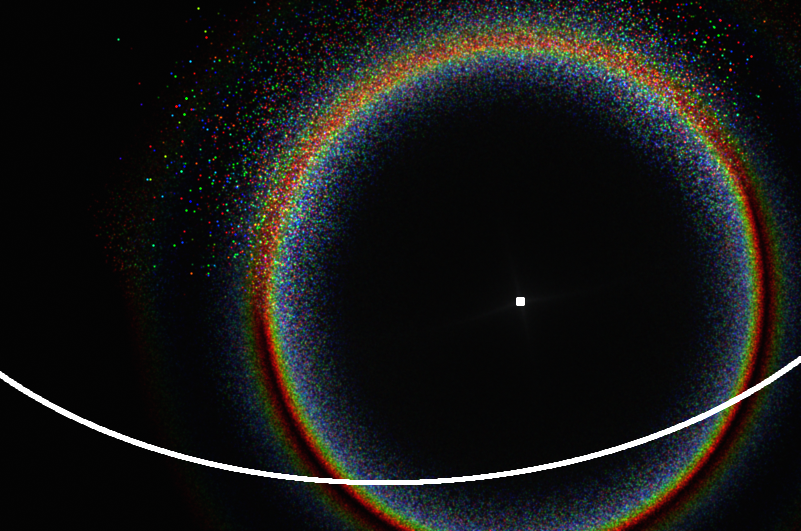


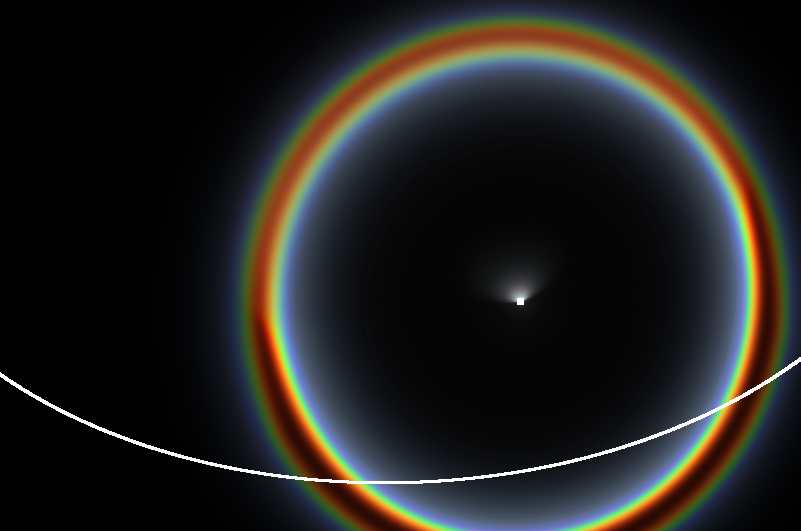
The latter result illustrates that in broad DSDs supernumeraries need the stabilizing “Fraser mechanism” [8] to become visible: If, with increasing drop size, the Möbius shifts grow in the opposite direction than the supernumeraries’ convergence towards the Descartes angle due to their shrinking angular width, there will be a certain critical drop size at which these effects compensate. Because of the resulting position stability against changes of drop radii, the supernumeraries of drops around the critical size will peak out from the unstructured background of superimposed non-aligned supernumeraries of other sizes. Traditionally, this argument is invoked for the primary rainbow (with a critical drop radius of about 0.25 mm for the first supernumerary), but it holds likewise for all other orders [9]. If the Möbius shifts have the wrong sign (as for the tertiary and quaternary bows at the sun elevation of my observation) or are set to zero (as in the sphere reference simulations), there exists no compensation point and the averaging of all supernumeraries results in a more or less uniform intensity gradient.
The GO simulations reproduce also the 7th order rainbow, but, under the assumed conditions, do not predict any amplification effects for it caused by drop distortions or oscillations. In fact, it is not even recognizable in the simulation pictures shown here, but can be extracted by a larger intensity-to-RGB-value scaling factor (or higher gamma value).
In conclusion, the observed concentric tertiary and quaternary rainbows without supernumeraries can be consistently interpreted in the current theoretical framework of broad raindrop size distributions and drop shapes with aerodynamically plausible amounts of flattening and oscillations. Even though shape distortions have a larger influence on higher orders, they do not forbid that traditionally shaped rainbows are formed, if enough small drops are present. Of course, any observations of genuine non-spherical drop effects such as higher order twinned bows are highly welcome as they would allow for a more challenging test of the simulation models.
A multi-split rainbow from south-east China, August 12th, 2014
Twinned rainbows are rare sightings, in the sense that one may see on average only one per year in Central Europe even when paying close attention. Much rarer still, and maybe restricted to regions closer to the equator, are multi-split rainbows. Only few cases have been documented so far [1, 2, 3], though more snapshots can be found on image sharing platforms labeled as “triple rainbow” etc. It is always a very favorable situation if an archivist and analyst like myself can establish direct communication with a skilful observer, who recorded details of a rainbow display that provide some insight beyond the pretty pictures.
In April 2019 I emailed Mr. Ji Yun, who manages a Facebook group dedicated to atmospheric optical phenomena in China, asking about a spectacular photograph of a multi-split rainbow which had been shared there. He kindly relayed my request to Mr. Liu Hai-Cheng, the original observer. Mr. Liu agreed to answer a long list of questions and I also received two sets of photographs from August 12th, 2014, one from his Sony NEX-5C camera (equipped with a Nikon AF 28mm f/2.8 lens) and the other from his cell phone (Coolpad 8720L). The camera clock’s time stamps were calibrated with respect to the actual local time by comparing camera and cell phone pictures, and assuming the cell phone clock to be synchronized over the network. All time data are given here in Chinese standard time (UTC+8h).
Mr. Liu observed this rainbow rarity in the beautiful landscape of the karst mountains near the Yulong bridge (Yangshuo County, Guilin City, Guangxi province, about 400 km northwest of Hong Kong, 24.8° N, 110.4° E) during a boat trip on the Yulong river. He remembers that it was very hot that afternoon. It began to rain before he passed through the tunnel of the bridge (at about 16:50), with some heavier rain lasting for about 25 minutes. There was no lightning, thunder or strong wind.
Judging from the photos, the rainbow appeared at about 17:10 within 30 s or less. Already on the early photographs there are hints of the unusual splitting of the primary:
However, Mr. Liu’s visual impression was that the splitting became prominent only later, after the (seemingly ordinary) primary and secondary bow had appeared successively. He also noted that the visibility of the split branches changed over time, while the main primary could always be seen clearly.
Towards the end of the shower, the display reached its peak quality. The following pictures cover the full right-hand side of the rainbow and some of the left. They are presented without additional filtering to allow for a better assessment of the natural contrast conditions.
For a deeper analysis, I chose the title picture, recorded at 17:18. In the contrast-enhanced version, three primary branches are directly visible, with the most intense one in the center. The secondary rainbow, as far as it is included in the frame, does not exhibit any anomalies. This is a typical feature in (almost) all split rainbow observations known so far. My goal was now to transform the photograph into the scattering angle vs. clock angle coordinate system (in equirectangular projection), as I did on previous occasions [1, 4]. The scattering angle is the angular distance from the sun, and the clock angle the azimuth around the rainbow’s circumference, with the 0° position corresponding to its top.
The sun’s position is easily obtained from standard astronomy software (giving an elevation of 25.4°, and azimuth of 275.4°). Additionally, the precise focal length of the lens (in pixel units) and distortion characteristics need to be known, as well as the camera pointing direction in elevation and azimuth, and the angle describing the rotation of the sensor’s pixel grid with respect to the vertical.
To precisely determine these quantities, a rather extensive calibration must be carried out. Here I had to try some reasonable guessing: There is a nominal focal length in mm, the sensor data (pixel pitch) can be looked up, as well as some distortion information for this specific lens. From aerial pictures showing the river and individual mountains, the viewing direction can be estimated. The appearance of the water surface gives some clues about the camera rotation. In combination, all these estimations allow for a plausible transformation:
Assuming this reconstruction to be not too far off, it is immediately obvious that the bright central branch does indeed fit to the conventional primary rainbow locus at a constant scattering angle of about 138°. As expected, the secondary ends up at about 129°, also as a straight line. The lower branch (i.e. at higher scattering angles) can in principle be explained by aerodynamically flattened raindrops, following a long tradition in rainbow physics [5, 6, 7, 8, 4]. However, the upper branch penetrating into Alexander’s dark band requires elongated raindrops, whose existence cannot be accounted for by aerodynamics alone. Electrostatic fields [9] can elongate raindrops, but in the absence of any lightning activity it is speculative if any higher fields were present. Elongated shapes do also occur as transitory states during oscillations of larger drops in the appropriate (axisymmetric) modes [10].
The problematic element in this explanation is, however, that in the case of the rainbow we deal with a large number of contributing raindrops and a temporal average due to the finite exposure time. So we need an argument why contributions from transitory states are not simply wiped out. The resonance frequencies of the individual drops depend on their size, so no singular event such as an acoustic shock wave from thunder (if there had been any at all) can synchronize the oscillations. The only plausible idea for a formation of stable rainbow branches by drop oscillations in a stochastic ensemble might be that the two extremal states of the oscillation (flattened and elongated) are encountered with a higher probability than intermediate ones, as the momentary velocity decreases to zero at the turning points of any classical oscillation. Admittedly, this requires a rather narrow distribution of amplitudes throughout the ensemble (at least in the dominant drop size range), as otherwise the branches will be wiped out again due to the spread in extremal axis ratios. To my knowledge, there is not enough data on the statistical properties of oscillations in large ensembles of natural raindrops published yet to draw a definitive conclusion here.
Some further details of this observation are worth to be noted: The three branches of the primary bow appear each in a distinct fashion: The lowest is broad and rather diffuse, the middle one is bright and shows the features of a typical primary rainbow, the top one is narrow with a sharp uppermost outer rim. Moreover, it gives the impression of having developed a downward sub-branch in the –10°…+5° clock angle interval, resulting in a four-fold split bow there.
Rainbows certainly go on fascinating people all over the world, and rightfully so: Even in the 21st century, some outstanding displays occur from time to time that still challenge our understanding. Maybe those in hotter climates with intense rain showers have better chances of catching such rarities. In any case, we have to go out and take a look and a picture at the right time.
Quinary rainbow in lamplight, plus a twisted primary and nice supernumeraries
In my last blogpost, I described how tertiary and quaternary rainbows in the light of a halogen lamp and made by drops from a spray bottle can be photographed. The quinary rainbow I had not been able to detect back then, so I gave it another try two weeks later (on April 14th, 2018).
I chose a more conventional wide angle lens with f = 18 mm (Pentax DA 18-55 mm at a Pentax K-5 camera) instead of a fisheye this time, so that both the peak illumination intensity and the drops can be confined to a specific rainbow sector without the need to care about the rest of the rainbow circumference. Also, I hoped that a lens hood (which cannot be applied to a fisheye objective) might help somewhat against the wetting of the front lens by drifting drops. However, this did not work out, and the wetting problem did in fact worsen due to the fact that the lens has now to be pointed upward to capture the upper sections of the rainbows against the sky. This creates a much more efficient target for falling drops.
I started with a nice shot of a primary and secondary rainbow against the night sky, which might be mistaken as a lunar rainbow at first glance – but, as mentioned, both illumination and drops were purely artificial:
I then took about 40 pictures, both upwards as well as pointed horizontally to the right side against the vegetation background, without any additional polarizers. A signature of the quinary rainbow appeared in only a single frame of this whole series, recorded shortly after the one shown above. I suppose that even wiping the front less does not help to much after a while, as the lens will fog up again shortly afterwards. The diffuse background resulting from even a slightly fogged lens might be enough to mask the quinary. For the next experiment I plan to install a small battery-powered hairdryer or something of that sort to keep the lens dry. Anyway, here is the picture:
with increased contrast and saturation:
The arrow points to the green/blue stripe of the quinary rainbow inside Alexander’s dark band.
Ironically, I had taken this only as a fun shoot because of the twisted look of the primary, and did certainly not expect it to be the only reference image for the quinary from this series. At the location of the dark band crossing the primary, the shadow of the spray bottle was cast on the drop cloud, which suppressed part of its “rainbow response”. The remaining drops outside the shadow might have had a different size, and/or the remaining divergence of the light source did play a role. Even at a distance of 10 m from the lamp, a lateral displacement of a drop by 50 cm corresponds to a shift in the lamp position (as seen by this drop) of about 3°. So the deviation of the Minnaert cigar (which has more of an apple shape here) from an ideal cone will still have an appreciable influence. This can only be reduced by increasing the distance to the light source or by confining the drop cloud to a region closer to the camera.
As already mentioned in the last blogpost, and being also visible in the picture above, beautiful supernumeraries at both the primary and secondary rainbows can become visible for several seconds. Finally, here are several pictures that show more of their variety:
How you can photograph tertiary rainbows every night
After almost 7 years since the first successful documentation of higher-order rainbows, we are now aware of at least 40 photographic observations of tertiary bows, sometimes accompanied by quaternaries. It is the more surprising that so far no one seems to have tried an outdoor experiment using artificial light and drop sources to bridge between the natural observation and single-drop scattering experiments, in which caustics are projected onto a screen.
Such an outdoor setup does not only allow to test various cameras and post-processing methods, but may also help to introduce newcomers to the challenges of observing higher order bows against the intense zero order background. Also very practical issues such as drops on the front lens or wet cameras can be directly experienced.
The setup is quite similar to what is used for diamond dust halo observations in Finland. The experiment is carried out at night in order to exploit the optimal background conditions of a dark sky. A bright searchlight lamp creates an almost parallel light beam with small opening angle, in which the camera is placed. Direct illumination of the camera is blocked by a cardboard disc placed roughly halfway between lamp and camera. This also helps in the case of photographing primary and secondary rainbows (i.e. the lens is pointing away from the light source), as stray light entering through the viewfinder on the camera backside can spoil the pictures.
I tested both Xenon (HID) and halogen lamps in the power range of 50-100 W. While Xenon lamps are brighter at the same power consumption, their non-thermal emission spectrum may lead to rainbows whose color is dominated by blue and yellow only, also the emitted light can show unwanted yellowish tinges in certain emission directions. The pictures shown here were therefore taken using the 100 W halogen lamp.
Drops were created by an ordinary spray bottle and, as judged by the appearance of the rainbows, are somewhat smaller than the ones in natural rainbows. Due to wind or movements of the bottle a spatial separation of smaller and larger drops can occur, as indicated by several well formed supernumeraries on both the primary and secondary rainbows which become visible for some moments. However, I decided not study these detail here, and tried to create a more or less spatially homogeneous spray including all available drop sizes over the exposure time of 2-5 s for each picture.
This is how the primary and secondary rainbow look like:
(camera: Pentax K-5, lens: Pentax-DA fisheye 10-17 mm at f = 10 mm, f/3.5, ISO 200, 5 s)
At that time, there was also some light natural drizzling going on, which generated only a weak primary rainbow in the lamplight. The limiting factor here is not the much lesser density of drops than in the spray (this could be helped by longer exposure times or stacking), but rather the background illumination of the sky (the pictures were taken in my garden in Hörlitz, Germany, which is a rather rural, but still pretty illuminated place, and there was also the nearly full moon behind the clouds on the evening of April 1st, 2018).
(f = 10 mm, f/3.5, ISO 200, 30 s)
When reversing the camera viewing direction, the zero order glow (=light which is transmitted through the drops without reflection) is, as expected, the dominant feature in the photographs:
(f = 10 mm, f/3.5, ISO 400, 2 s)
After strong unsharp masking, the tertiary rainbow is extracted, and can be traced almost completely around its full circumference:
As the camera was directed straight to the lamp (and rainbows thus appear as circles around the image center), it is possible to apply a radial smoothing filter to enhance the visibility further:
Here is another picture, taken with the same settings and processed similarly, which clearly shows in addition the quaternary rainbow in the upper left quadrant:
A major problem is that drops on the front lens disturb the recorded rainbows massively, as becomes apparent after unsharp masking. This problem is especially severe when using a fisheye lens (which does not have a suitable lens hood), and under windy conditions which shift the drops into unexpected directions due to swirled gusts near the ground. Periodical wiping of the front lens is therefore indispensable. Of course, the camera itself should be proof against spray water.
It is known from calculations that the contrast of the tertiary rainbow lies close to the detection limit of the human eye (see here and here), at least for purely spherical water drops. Here, no traces of it could be seen directly, even when looking through a polarizer. The main problem is that the spray lifetime is only a few seconds and the observer is constantly busy to maintain a more or less constant amount of drops in the air, which is rather distracting. A garden hose may be worth testing in the future.
So far, no unambiguous traces of the quinary rainbow (see here and here) could be extracted from Alexander’s dark band, in which its green and blue parts are expected to follow immediately the red rim of the secondary. There are several reasons which make its detection difficult here. At first, the drops are generally smaller and thus the secondary rainbow wider than in a natural setting. Next, the weak but non-zero divergence of the illumination may blur the rainbow positions further. Also, the background includes green plants in some directions which hinders the detection of green rainbow features. A more detailed study using a darker background and a narrower drop size distribution (with appreciable supernumeraries) seems necessary.
Third and fourth order rainbow
In the late afternoon of July the 7th 2017 there were strong thunderstorms in the area around Berlin, Germany. AKM member Andreas Möller was driving trough heavy rainfall, when suddenly the sun came out. His report:
On my way home, I could observe a beautiful bright primary and secondary rainbow. It was still raining heavily and my intension was to observe the area towards the sun. Therefore I turned into a side street and stopped in front of an old industrial area.
Location details:
- Ferdinand-Schultze-Straße 18, 13055 Berlin, Germany
- Weather: Strong rain
- Sun altitude: ~19°
- Date: 2017-07-07
- Time: 19:00 – 19:08 CEST
https://kachelmannwetter.com/de/regenradar/stadt-berlin/20170707-1705z.html
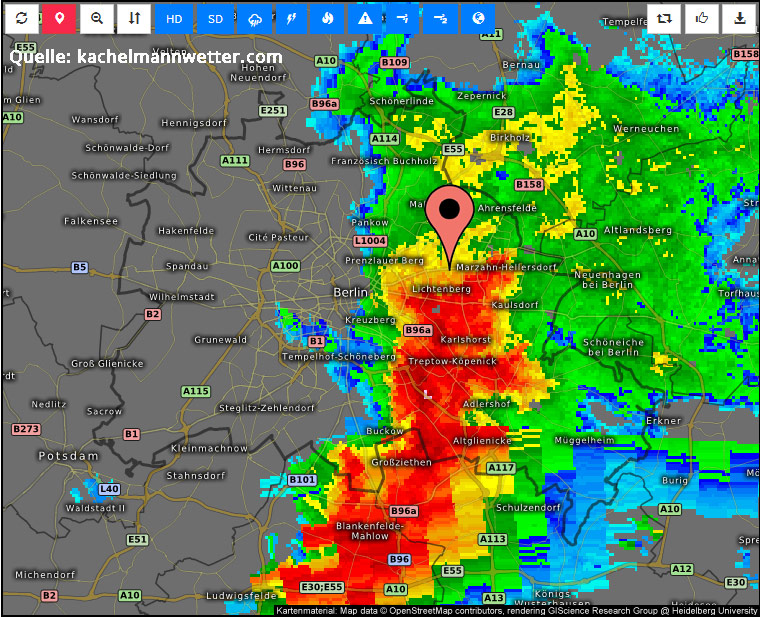
I took a lot of pictures in hope to get the third and fourth order rainbow. My equipment was a Nikon D750 with a Tamron SP 15-30mm f/2.8 at 15mm. The rain was strong and I had problems cleaning my lens from waterdrops. Later at home, I started to process the pictures directly. Amazingly, I could discover the third and fourth order in almost all of the pictures I took.
The image processing did clearly point out a colorful third and fourth order rainbow.
Processing details:
- stack of 8 frames
- unsharp masking (USM)
- contrast and light adaption with Photoshop
- unsharp masking with Photoshop
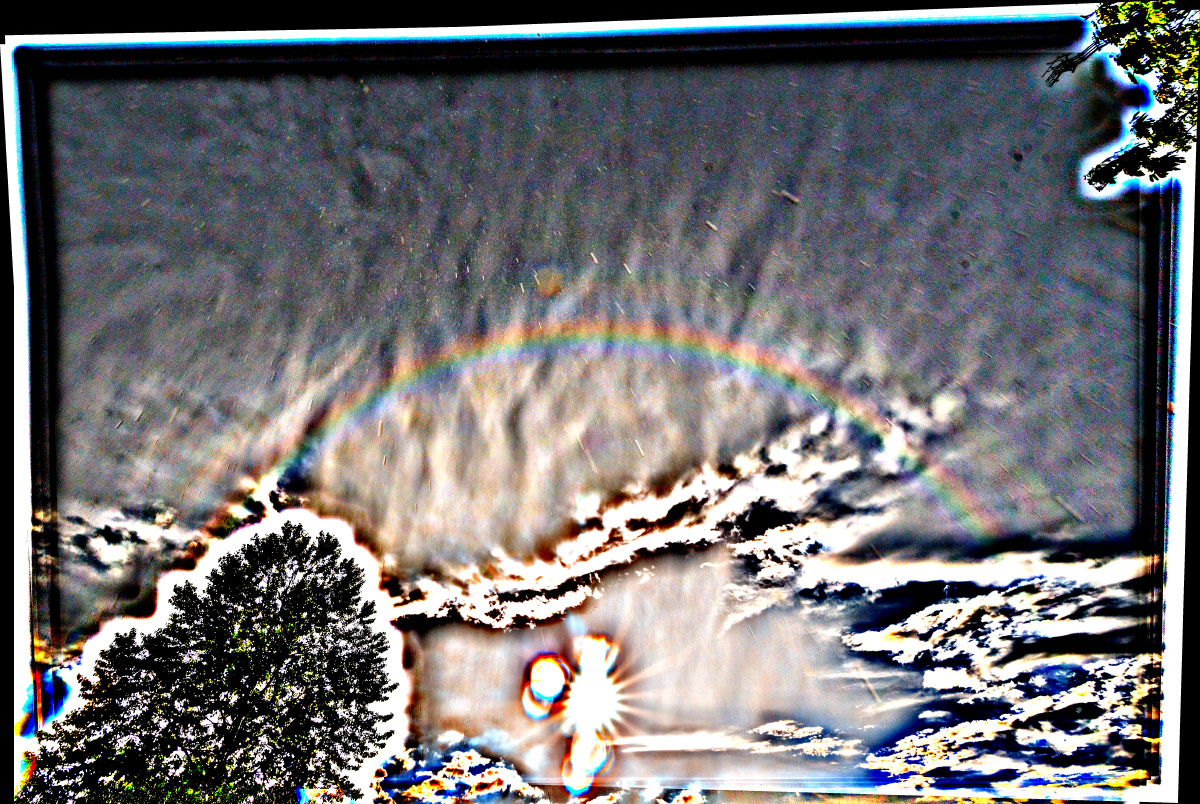
Here is another image processed out of a single RAW file. (USM)
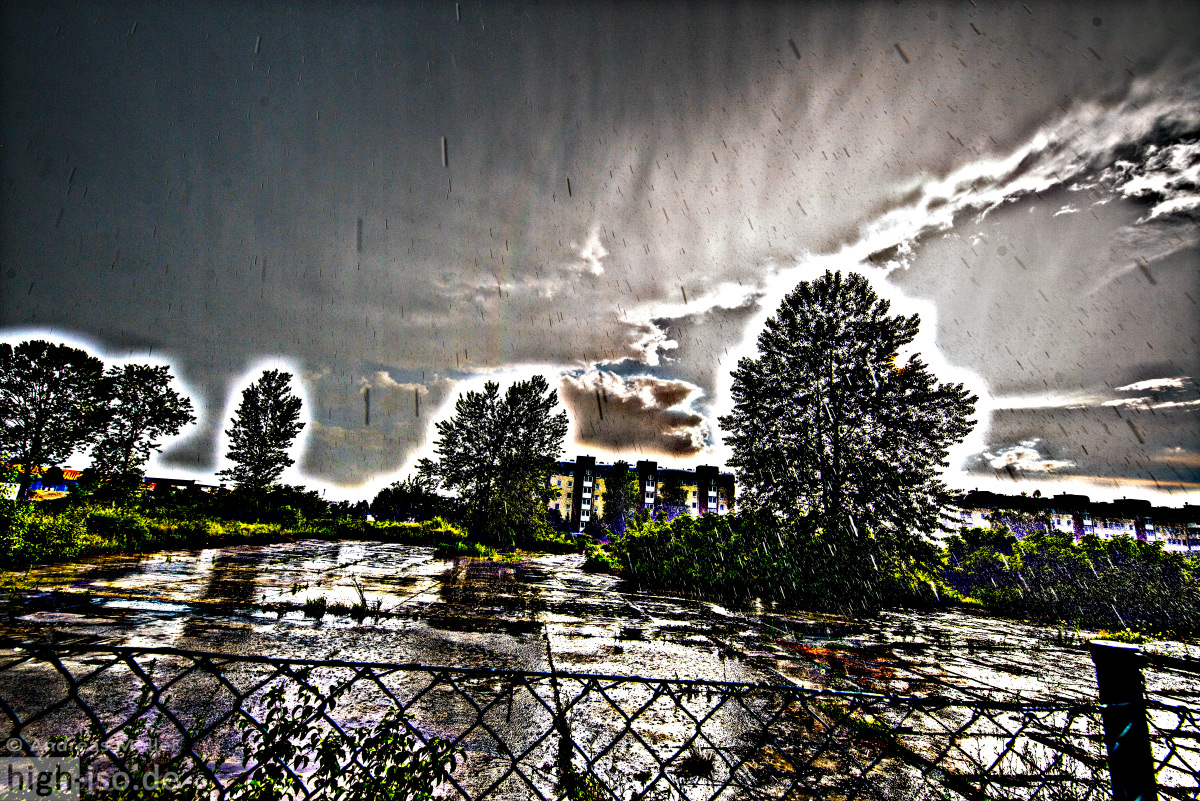
Binary double rainbows
In past years I have done spot light rainbows when the rain was a fine mist. After seeing the results of a nice fog bow my LED flashlight made and since I had two I thought why don’t I try doing two at once. So I turned both lights on the hi-power mode which yielded a very bright beam of light and both lights were placed on fence posts 2 meters apart. I angled the lights so the beams crossed and at the point where they crossed is where I placed the camera. I took a shot was blown away by the results! There it was two full circle double rainbows crossing one another. I took quite a few shots before I was getting chill and wet. Just think if you landed on an Earth like exo-planet orbiting a binary star system and upon exiting your space craft you look up and see twin suns shining above then you hear a rumble of thunder. You retreat into your ship for shelter and later the storm moves on but its still raining but you look on the opposite side of the sky and see two double rainbows displaced a few degrees apart and the bows would cross one another. These flashlight binary double rainbows show how rainbows would look to civilizations living on Earth like Exo-planets orbiting double, triple, or even quadruple star systems. Next time I will use 3 and 4 LED flashlights. On the nights I was doing these bows the wind was blowing and I could see the primary bow in particular would move from side to side and one pic even shows that it could be twinned!!!
Author: Michael Ellestad, USA
Three possible photographic detections of the natural fifth order rainbow from Germany
In 2014, Harald Edens reported ten cases of photographically detected natural quinary rainbows, recorded during 2009-2013 in New Mexico, USA, at altitudes of 1.8-3.2 km. These and some newer observations can also be found on his website.
So far, no reports from other locations have been published. In the German observers’ network, we analyzed many candidate photographs showing bright primary and secondary rainbows, but from most of them no reliable traces of quinary rainbows could be extracted. Such analyses are not easy, as the quinary signal is weak compared to the neighboring secondary rainbow, and processing methods such as unsharp masking can cause a leakage of colors into Alexander’s dark band. Furthermore, the processing operator will experience disturbing afterimage issues from the intense renditions of the primary and secondary on the screen after a couple of minutes.
Despite these difficulties, we now believe that we have identified three cases of genuine quinary rainbows. In cases 1 and 3, the quinary could be extracted from several photographs. Nonetheless, in order to keep this blogpost brief, we restricted ourselves to show only one image (or the results from one polarization series in case 1) per observation. We chose a straightforward processing method (= only increasing contrast and saturation, no local filtering such as unsharp masks) similar to the one applied by Harald Edens to allow for an easier comparison with his results. Alternative processing routes will be presented at a later stage.
1) April 22nd, 2012, near Göttingen, Germany (51° 31’ N, 9° 58’ E, altitude 250 m), 19:16 CEST, sun elevation 10.2°, photographed by Frank Killich after a moderate shower
The original intention of Frank Killich was to use the primary and secondary rainbows as test objects for a home-built photopolarimetric setup made from a Canon 20D camera and a linear polarizer precisely rotatable by a stepper motor. By recording four successive images at polarizer positions of 0°, 45°, 90° and 135° with respect to the vertical, it is possible to reconstruct the first three components of the Stokes vector for each viewing direction (pixel coordinates) and color channel (red, green, blue) individually. These images can be numerically combined to reconstruct the unpolarized intensity (= the ordinary photographic result without a polarizer) and, moreover, the linearly polarized portion of the recorded light distribution (= the total intensity with the unpolarized background removed for each pixel). In the case of rainbows, this corresponds effectively to a subtraction of the radial (weak) component from the azimuthal (strong) polarization component equally all along the visible part of the circumference. As known from theory, also the quinary will be easier to detect in such a polarization contrast image.
Unpolarized intensity as calculated from the original images, f = 22 mm:
Unpolarized intensity, increased saturation and contrast:
Linearly polarized portion as calculated from the original images:
Linearly polarized portion, increased saturation and contrast:
The expected broad bands of green and blue are clearly visible in the processed linearly polarized portion picture, and might be slightly visible also in the unpolarized intensity.
The other two photographic observations were carried out without any polarizers, i.e. only the unpolarized intensity information is available in these cases.
2) March 20th, 2013, near Pforzheim, Germany (48° 56’ N, 8° 36’ E, altitude 312 m), 16:21 CET, sun elevation 21.1°, photographed by Michael Großmann after an intense shower
Original (Canon EOS 450D, f = 22 mm):
Increased saturation and contrast:
A slight green/blue hue is visible inside the secondary at and slightly above the horizon.
3) May 15th, 2016, Mt. Zschirnstein, Germany (50° 51’ N, 14° 11’ E, altitude 560 m), 19:57 CEST, sun elevation 6.2°, photographed by Alexander Haußmann after a moderate shower
A description of this observation (without discussing the quinary rainbow) can be found here. The images shown here are cropped from a fisheye photograph.
Original (Pentax K-5, f= 17 mm, cropped):
Increased saturation and contrast:
Again, a slight green/blue hue appears close to the horizon.
At this point it is of course not possible to draw any statistical conclusions about the frequency of detectable quinary rainbows. However, it seems worthwile that every rainbow observer re-examines his photographical treasure trove for previously overlooked rarities, even if no polarizer enhancement was involved during photographing.
Fogbows in Tenerife
11th of May, 2016 Roberto Porto observed in the Teide National Park (Tenerife, Spain) wunderful fogbows in top of a deeper cloud layer. The moderate climate of Tenerife is controlled to a great extent by the tradewinds, whose humidity is condensed principally over the north and northeast of the island, creating cloud banks that range between 600 and 1,800 metres in height. If moves out of the cloud layer as far as you can see the sun, one has with the sun behind the best observing conditions for a fog bow.
As the name might suggest, a fogbow is the name given to a phenomenon created by the same process of refraction and reflection that creates rainbows, but formed instead by the water droplets in fog, mist or cloud, rather than raindrops.
The timelapse video show 3 different fogbows in the sea of clouds of Volcano Teide. The sun low in the horizon produced the beautiful fogbows.
Photo data: Nikon D5300 and Nikon D90 with Nikkor fish eye 10,5 f:2,8 and tamrom 18-200mm
Unpaired reflection rainbow
The ever growing number of webcams is worth to be checked for both common and rare atmospheric optics phenomena, e.g., like in the case of these twinned rainbow, rainbow at high and low sun (1–2–3–4), red rainbows (1–2–3–4) or moonbows (1–2–3–4).
The Swiss webcam located in Cully at the North shore of Lake Geneva (Lac Leman) has shown a most unusual pair of images within 10 minutes on May 25th, 2016. Starting from the last image (see top right) taken at 20.40 Central European Daylight Saving Time we see fragments of a normal primary rainbow before sunset, which happened at 21.08 CE-DST. From its beginnings on the lake’s surface it is immediately slanted toward the antisolar azimuth in the East.
However, the image taken 10 minutes earlier (see top left), at 20.30 CE-DST, shows not just a weaker bow, but also, that it starts at the lake’s surface slanted toward the West, i.e. away from the antisolar azimuth!
This strange sight is an isolated reflection rainbow, which is also centered on the antisolar point, but, at the solar elevation of 4.9°, somewhat larger than a semicircle, thus explaining the odd slant at its foot. The missing of a normal rainbow (except of, may be, a slight trace) in this image can be explained by a very patchy type of rainfall or shadowing of the corresponding regions. Additionally, the images show hints of a reflected rainbow and a reflected reflection rainbow, respectively, projected on to the lake’s surface.
Authors: Elmar Schmidt and Claudia Hinz
Twinned rainbow from Russia
In June 21, 2016 Ivanna Dark observed Yurga, Kemerovo region in Western Siberia, Russia an clear twinned rainbow: “At 19:45 local time (UTC + 7) began to fall to the ground a few large drops of very weak rain. I decided to look at the rainbow, because I know that it will appear in the presence of the sun. Imagine my surprise when I saw that the rainbow has a certain strangeness. It was not a Supernumerary Rainbows, but seen clearly, that the top part split into equal pieces. Later I found out the name of this phenomenon – Twinned Rainbow. Although the rainbow was very faint and lasted about two minutes, it did not stop to notice the duality of top.”



